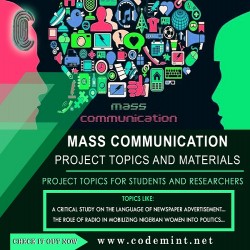- The Complete Research Material is averagely 99 pages long and it is in Ms Word Format, it has 1-5 Chapters.
- Major Attributes are Abstract, All Chapters, Figures, Appendix, References.
- Study Level: BTech, BSc, BEng, BA, HND, ND or NCE.
- Full Access Fee: ₦7,000
Get the complete project »

ABSTRACT
This study sets out to determine Parents’ Perceptions of the Influence that Social media networking have on their Children with special focus on parents whose children attend Demonstration Secondary School Zaria. The study adopts descriptive Research design while survey was use as method of data collection and questionnaire was employ as instrument for data gathering. The research adopts simple percentage as method of data analysis. Of a total population of 1,974 parents of students in the senior secondary classes, 450 parents constitute the researcher’s sample size thereby representing the whole. This sample was picked using purposive sampling method. The study finds that parents had different perceptions of the influence that social media networking have on their children. The study goes on to show that, 76.7% of the respondents are computer literate. Even though most of the study population (84%) had access to the internet, only 46.6% are registered on one social media or the other. The study also shows that it is difficult to deny children access to the social media because advances in technology have made internet accessibility via mobile telephone possible. Findings show that parental monitoring is a mediating factor in supervising children’s activities online. The researcher therefore, recommends that parents should learn to create a conducive and communicative home environment were their children can feel at home to discuss online issues bothering them. The study further recommends that, parents, rather than stop their children from joining these networks, should be supportive of any effort towards educating them about the negative influence that the social media may have on them any time they visit their accounts. This is more so because children can neither be denied access to these social networks nor be stopped from joining them.
CHAPTER ONE
1.0 INTRODUCTION
1.1 BACKGROUND TO THE STUDY
The advent of the internet has made today‟s web more than an electronic bulletin board, and the
days of using the internet as a mere one-way supplier of news, is over. With social media tools,
information can be exchanged back and forth (McCrea, 2010; Munkittrick, 2010; Wallace,
2006).
A social media networking website is an internet website containing profile web pages of
members that include their names or nicknames along with their photographs or any other
personal or personality identifying information placed on such pages and linked to other profile
web pages of friends or associates on the social networking websites. As such, members can be
accessed by other members or visitors to the websites. A social networking website provides
members and visitors to such website, the ability to leave messages or comments on the profile
web page that are visible to all or some visitors to the profile web page and may also include a
form of electronic mail for members of the networking site (Boyd & Nicole 2007).
According to Pro and Cons (2010:3), a social media network is defined as “an online services
platform, or site that focuses on building and reflecting of social networks or social relation
among people who share interests and/or activities. A social network essentially consists of a
representation of each user (often a profile), his/ her social links, and a variety of additional
services”. Examples of social media networks are; Face book, Twitter, 2go, MySpace and the
rest of them. In a broader sense, social networking means an individual or group-centred service
that allow users to share ideas, activities, events, and interest within their individual or group
networks.
11
All over the world, people experience joy when they form new social attachments and react with
loneliness and despair when these bonds are broken. Previous research by media scholars show
that, people who have a network of family and friends are happier and healthier and live longer
than those who are more isolated. People need people, which are why social situations can have
such a profound effect on our thoughts, feelings, and behaviour (Kabakci, Ferham andAhmet,
2008).
For society to exist, certain communication needs have to be met. Such as; the ability to read and
write. Over the years, human beings have so explored and utilized communication that we now
live in a media age. Today, the mass media have become a persuasive part of our lives, possibly
because a combination of technological, economic and social factors have led to several media
that have pervaded contemporary society. These trends, among others, include the internet,
mobile phones and the social media. Indeed, mobile phones and social media have become so
prevalent that the world has virtually „shrunk‟ to what is termed a global village. Children now
use the social media networks to satisfy their communication needs. This is however, not without
some fears and challenges.
In ancient times, say some 200,000 years ago (Dominick, 2011), language developed and this led
to the development of oral culture - a culture that relied heavily on memory. As humans
developed, it became more and more difficult to rely on oral communication. Writing became the
next big development as the need to keep more detailed, permanent and accessible records arose.
Thus around 1450, printing developed and made the written word an important means of
communication. However, as printing and books became expensive and exclusive, technological
developments led to the era of the electronic media (Dominick, 2011). The telegraph,
12
photography, radio, television, computer and the internet, all changed the way people
communicated with one another and the way information is stored and transmitted. Cell phones,
laptops and other mobile information devices have further widened the horizon of
communication.
Moreover, The United State Federal Trade Communication (2010) observed that children from
ages 13-17 are heavy users of digital technology and new media applications, including social
networking, mobile devices, instant messaging and file sharing. The online world has changed
You either get what you want or your money back. T&C Apply

You can find more project topics easily, just search
-
SIMILAR MASS COMMUNICATION FINAL YEAR PROJECT RESEARCH TOPICS
-
1. THE ROLE OF THE MEDIA IN MITIGATING AGAINST FEMALE SECONDARY SCHOOL DROP OUTS: A STUDY OF SOME SELECTED SCHOOLS IN SABON GARI LOCAL GOVERNMENT AREA OF...
» CHAPTER ONE 1.0 BACKGROUND TO THE STUDY 1.1 Introduction Education is a process of mapping experiences and finding a variety of reliable routes to opt...Continue Reading »Item Type & Format: Project Material - Ms Word | 66 pages |
 Instant Download
|
Chapter 1-5 |
MASS COMMUNICATION DEPARTMENT
Instant Download
|
Chapter 1-5 |
MASS COMMUNICATION DEPARTMENT
-
2. THE ROLE OF PARTICIPATORY COMMUNICATION IN THE OPERATION AND ACTIVITIES OF COOPERATIVES SOCIETIES IN KADUNA IN ENGENDERING ECONOMIC EMPOWERMENT AND DE...
» ABSTRACT This study was carried out to investigate the role of participatory communication in the operation and activities of Cooperative Societies in...Continue Reading »Item Type & Format: Project Material - Ms Word | 98 pages |
 Instant Download
|
Chapter 1-5 |
MASS COMMUNICATION DEPARTMENT
Instant Download
|
Chapter 1-5 |
MASS COMMUNICATION DEPARTMENT
-
3. INFLUENCE OF NIGERIAN HOME VIDEO FILMS ON CRIMINALITY
» CHAPTER ONE INTRODUCTION 1.1 Background of the Study Nigerian movies, popularly referred to as Nollywood movies, produced by the Nigerian film industr...Continue Reading »Item Type & Format: Project Material - Ms Word | 52 pages |
 Instant Download
|
Chapter 1-5 |
MASS COMMUNICATION DEPARTMENT
Instant Download
|
Chapter 1-5 |
MASS COMMUNICATION DEPARTMENT
-
4. A PSYCHOANALYTIC READING OF WOLE SOYINKA’S DEATH AND THE KING’S HORSEMAN
» ABSTRACT Characterization or characterisation is the representation of persons (or other beings or creatures) in narrative and dramatic works of art. ...Continue Reading »Item Type & Format: Project Material - Ms Word | 66 pages |
 Instant Download
|
Chapter 1-5 |
MASS COMMUNICATION DEPARTMENT
Instant Download
|
Chapter 1-5 |
MASS COMMUNICATION DEPARTMENT
-
5. THE IMPACTS OF BILLBOARD ADVERTISING ON PRODUCT PROMOTION
» ABSTRACTThe problem of this research work deals mainly on how billboard advertising can develop the print media. We know advertising revenue is one of...Continue Reading »Item Type & Format: Project Material - Ms Word | 50 pages |
 Instant Download
|
Chapter 1-5 |
MASS COMMUNICATION DEPARTMENT
Instant Download
|
Chapter 1-5 |
MASS COMMUNICATION DEPARTMENT
-
6. THE ROLE OF ANTI-GRAFT AGENCIES IN ANTI- CORRUPTION CAMPAIGNS IN NIGERIA: (A CASE STUDY OF ECONOMIC AND FINANCIAL CRIME COMMISSION (EFCC)
» CHAPTER ONE INTRODUCTION 1.1 BACKGROUND TO THE STUDY 2 Before this country could be free from corruption, its deem fit to invite certain bodies like E...Continue Reading »Item Type & Format: Project Material - Ms Word | 26 pages |
 Instant Download
|
Chapter 1-5 |
MASS COMMUNICATION DEPARTMENT
Instant Download
|
Chapter 1-5 |
MASS COMMUNICATION DEPARTMENT
-
7. PUBLIC RELATIONS STRATEGIES IN CRISES MANAGEMENT IN UYO LOCAL GOVERNMENT COUNCIL
» TABLE OF CONTENTS CHAPTER TITLE PAGE Title page i Declaration ii Certification iii Dedication iv Acknowledgments v Abstract vii Table of Contents viii...Continue Reading »Item Type & Format: Project Material - Ms Word | 52 pages |
 Instant Download
|
Chapter 1-5 |
MASS COMMUNICATION DEPARTMENT
Instant Download
|
Chapter 1-5 |
MASS COMMUNICATION DEPARTMENT
-
8. THE IMPACT OF WOMEN JOURNALIST ON NIGERIAN BROADCAST MEDIA
» Abstract Traditionally, women have been involved in different trade and profession from time immemorial. For journalism, women role cannot be wished a...Continue Reading »Item Type & Format: Project Material - Ms Word | 100 pages |
 Instant Download
|
Chapter 1-5 |
MASS COMMUNICATION DEPARTMENT
Instant Download
|
Chapter 1-5 |
MASS COMMUNICATION DEPARTMENT
-
9. ONLINE ADVERTISING AND CONSUMERS’ PERCEPTION ON PURCHASE DECISION OF SMARTPHONES
» ABSTRACT Advertising as a profession and a field of study explains the reason why it cannot be underestimated. However, advertising in the 21st centur...Continue Reading »Item Type & Format: Project Material - Ms Word | 99 pages |
 Instant Download
|
Chapter 1-5 |
MASS COMMUNICATION DEPARTMENT
Instant Download
|
Chapter 1-5 |
MASS COMMUNICATION DEPARTMENT
-
10. MORTAL VISION, DESTINY AND PERSONAL CHOICE: A DIRECTORIAL ANALYSIS AND EXPERIMENT IN ELECHI AMADI’S ISIBURU
» TABLE OF CONTENTS Pages Title Page i Certification ii Dedication iii Acknowledgement iv Table of Contents v Abstract ix CHAPTER ONE 1.1 General Introd...Continue Reading »Item Type & Format: Project Material - Ms Word | 69 pages |
 Instant Download
|
Chapter 1-5 |
MASS COMMUNICATION DEPARTMENT
Instant Download
|
Chapter 1-5 |
MASS COMMUNICATION DEPARTMENT


